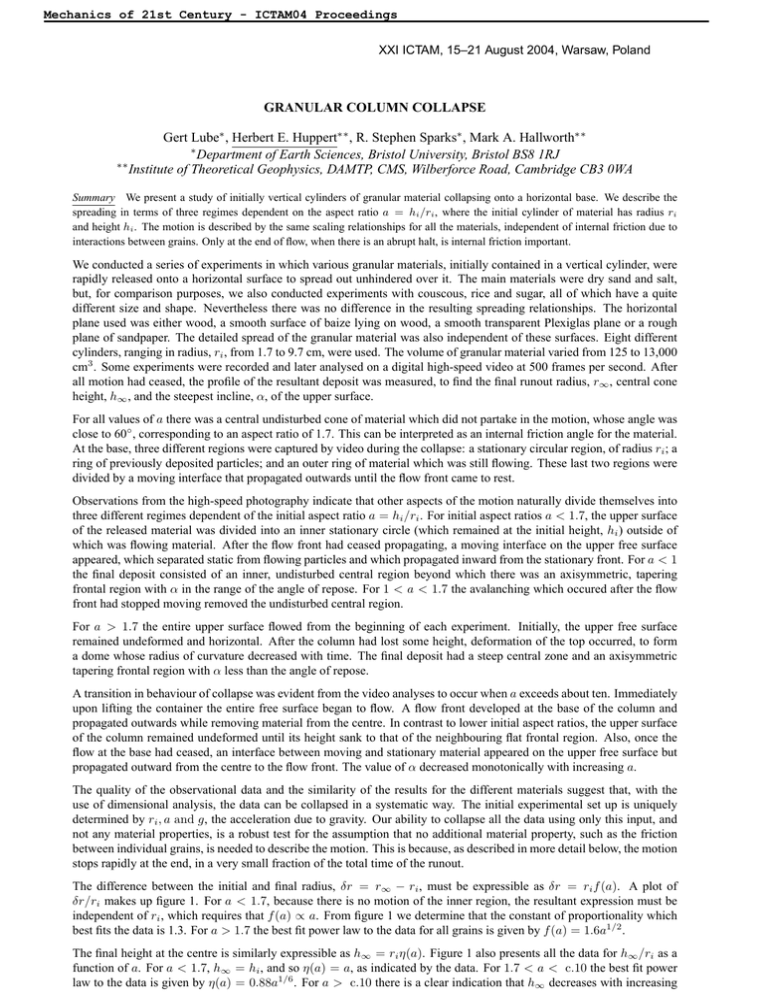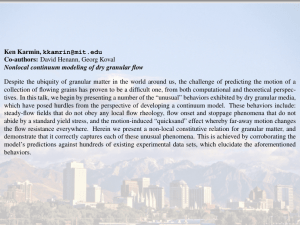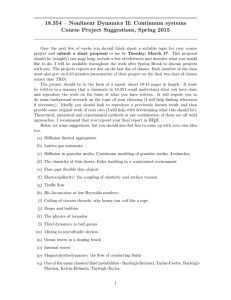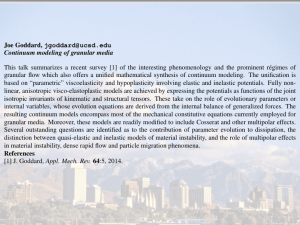GRANULAR COLUMN COLLAPSE Gert Lube , Herbert E. Huppert , R. Stephen Sparks
advertisement

Mechanics of 21st Century - ICTAM04 Proceedings XXI ICTAM, 15–21 August 2004, Warsaw, Poland GRANULAR COLUMN COLLAPSE Gert Lube∗ , Herbert E. Huppert∗∗ , R. Stephen Sparks∗ , Mark A. Hallworth∗∗ ∗ Department of Earth Sciences, Bristol University, Bristol BS8 1RJ ∗∗ Institute of Theoretical Geophysics, DAMTP, CMS, Wilberforce Road, Cambridge CB3 0WA Summary We present a study of initially vertical cylinders of granular material collapsing onto a horizontal base. We describe the spreading in terms of three regimes dependent on the aspect ratio a = hi /ri , where the initial cylinder of material has radius ri and height hi . The motion is described by the same scaling relationships for all the materials, independent of internal friction due to interactions between grains. Only at the end of flow, when there is an abrupt halt, is internal friction important. We conducted a series of experiments in which various granular materials, initially contained in a vertical cylinder, were rapidly released onto a horizontal surface to spread out unhindered over it. The main materials were dry sand and salt, but, for comparison purposes, we also conducted experiments with couscous, rice and sugar, all of which have a quite different size and shape. Nevertheless there was no difference in the resulting spreading relationships. The horizontal plane used was either wood, a smooth surface of baize lying on wood, a smooth transparent Plexiglas plane or a rough plane of sandpaper. The detailed spread of the granular material was also independent of these surfaces. Eight different cylinders, ranging in radius, ri , from 1.7 to 9.7 cm, were used. The volume of granular material varied from 125 to 13,000 cm3 . Some experiments were recorded and later analysed on a digital high-speed video at 500 frames per second. After all motion had ceased, the profile of the resultant deposit was measured, to find the final runout radius, r∞ , central cone height, h∞ , and the steepest incline, α, of the upper surface. For all values of a there was a central undisturbed cone of material which did not partake in the motion, whose angle was close to 60◦ , corresponding to an aspect ratio of 1.7. This can be interpreted as an internal friction angle for the material. At the base, three different regions were captured by video during the collapse: a stationary circular region, of radius ri ; a ring of previously deposited particles; and an outer ring of material which was still flowing. These last two regions were divided by a moving interface that propagated outwards until the flow front came to rest. Observations from the high-speed photography indicate that other aspects of the motion naturally divide themselves into three different regimes dependent of the initial aspect ratio a = hi /ri . For initial aspect ratios a < 1.7, the upper surface of the released material was divided into an inner stationary circle (which remained at the initial height, hi ) outside of which was flowing material. After the flow front had ceased propagating, a moving interface on the upper free surface appeared, which separated static from flowing particles and which propagated inward from the stationary front. For a < 1 the final deposit consisted of an inner, undisturbed central region beyond which there was an axisymmetric, tapering frontal region with α in the range of the angle of repose. For 1 < a < 1.7 the avalanching which occured after the flow front had stopped moving removed the undisturbed central region. For a > 1.7 the entire upper surface flowed from the beginning of each experiment. Initially, the upper free surface remained undeformed and horizontal. After the column had lost some height, deformation of the top occurred, to form a dome whose radius of curvature decreased with time. The final deposit had a steep central zone and an axisymmetric tapering frontal region with α less than the angle of repose. A transition in behaviour of collapse was evident from the video analyses to occur when a exceeds about ten. Immediately upon lifting the container the entire free surface began to flow. A flow front developed at the base of the column and propagated outwards while removing material from the centre. In contrast to lower initial aspect ratios, the upper surface of the column remained undeformed until its height sank to that of the neighbouring flat frontal region. Also, once the flow at the base had ceased, an interface between moving and stationary material appeared on the upper free surface but propagated outward from the centre to the flow front. The value of α decreased monotonically with increasing a. The quality of the observational data and the similarity of the results for the different materials suggest that, with the use of dimensional analysis, the data can be collapsed in a systematic way. The initial experimental set up is uniquely determined by ri , a and g, the acceleration due to gravity. Our ability to collapse all the data using only this input, and not any material properties, is a robust test for the assumption that no additional material property, such as the friction between individual grains, is needed to describe the motion. This is because, as described in more detail below, the motion stops rapidly at the end, in a very small fraction of the total time of the runout. The difference between the initial and final radius, δr = r∞ − ri , must be expressible as δr = ri f (a). A plot of δr/ri makes up figure 1. For a < 1.7, because there is no motion of the inner region, the resultant expression must be independent of ri , which requires that f (a) ∝ a. From figure 1 we determine that the constant of proportionality which best fits the data is 1.3. For a > 1.7 the best fit power law to the data for all grains is given by f (a) = 1.6a1/2 . The final height at the centre is similarly expressible as h∞ = ri η(a). Figure 1 also presents all the data for h∞ /ri as a function of a. For a < 1.7, h∞ = hi , and so η(a) = a, as indicated by the data. For 1.7 < a < c.10 the best fit power law to the data is given by η(a) = 0.88a1/6 . For a > c.10 there is a clear indication that h∞ decreases with increasing Mechanics of 21st Century - ICTAM04 Proceedings a. This is in response to the wave that originates from the centre and removes material outwards. Unfortunately, the data are a little too scattered to be quantitatively analysed with confidence. 100 Fig 1 δ r ri Fig 2 12 10 3a1 2 8 10 12 t ∞ ( ri g) 1 h∞ h i 6 4 ri = 9.7 cm ri = 7.45 cm ri = 2.91 cm 2 0.1 0.1 0 1 a 10 100 0 2 4 6 8 10 12 a 14 16 Figure 1. Nondimensional radial displacement and height at centre of pile. Points marked with a cross are for experiments in which the cylinder was raised height H from the base before releasing grains, and aspect ratio is defined as (H + hi )/ri . This shows that in the final runout distance only maximum initial height is relevant (and initial radius). Figure 2. Nondimensional time until the grain front ceased motion as a function of a. So far the parameter g has not entered our expressions because it is the only input parameter for which time is involved in its dimensions, and δr, h∞ /ri are both independent of time. The value of g will affect the total time for collapse, t∞ , which is defined as the time between the initiation of the experiment and that at which the flow front stops propagating. The high speed video, used on all the experiments with sand, allowed us to determine t∞ reasonably accurately. By dimensions, it must be of the form t∞ = (ri /g)1/2 ψ(a), for some function ψ(a). A plot of t∞ /(ri /g)1/2 as a function of a is presented in figure 2. As before, for a < 1.7, an expression independent of ri requires ψ(a) ∝ a1/2 , which is consistent with the data for a constant of proportionality of 3.8. For a > 1.7 thebest fit power law through the data yields ψ(a) = 3a1/2 , which indicates that t∞ = 3(hi /g)1/2 . Note that the time taken for a particle to fall a height hi under gravity is (2hi /g)1/2 , which is just less than a half of t∞ . Further insight on the flow characteristics is obtained by an analysis of our kinematic data on the radius of the flow front as a function of time, r(t). For all flows there was a primary acceleration phase during which the acceleration was approximately constant between 0.25 g and 0.3 g. For a < 1.7 this acceleration phase was followed by a phase of deceleration which came quite abruptly to a halt. For a > 1.7 these two phases were separated by a phase of constant velocity of the flow front whose duration increased with increasing a. This phase of constant velocity has an analogue with the evolution of a fluid axisymmetric gravity current spreading at high Reynolds number, which also goes through a stage of constant velocity [1]. A fluid current then adjusts under a balance between buoyancy and inertial forces, spreading like t1/2 [2] – the same result as obtained for the granular collapse described here. This analogy, which uses quantitative relationships to describe the motion of the granular medium that are closely analogous to those used to describe the motion of density currents of Newtonian liquids, further strengthens our argument that intergranular frictional effects play a negligible role until the abrupt halt commences. Obtaining the spreading relationships that our experiments have indicated remains a challenge for the future. In the meantime a clue to understanding the emplacement we have observed may come from an interpretation of the final stages, when the spreading pile comes to a rapid halt. It has been suggested that granular materials can be considered in two states [3]: a static solid state, where intergranular forces at particle faces give the material strength; and a liquid state, exemplified by granular flows and fluidised beds, where the particles are in an agitated state and the system has negligible strength. The abrupt cessation of the motion of the granular flows that we observed can be likened to a phase change between two states [4]. In accord with the characterisation put forward in [3], the change of state can be envisaged as a kinetic process analogous to solidification of a true liquid. In the case of a granular medium, we suggest that as the flow decelerates, the granular temperature falls below a threshold value and frictional interactions between particles become dominant and the granular material converts to a static solid (or deposit). References [1] [2] [3] [4] << session H.E. Huppert, J.E. Simpson, J. Fluid Mech. 99: 785, 1980. D.P Hoult, Ann. Rev. Fluid Mech. 4: 341, 1972. H.M. Jaeger, S.R. Nagel, Rev. Mod. Phys 68: 1259, 1996. H.E. Huppert, J. Fluid Mech. 212: 209, 1990. << start


